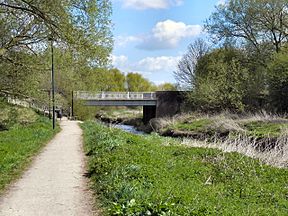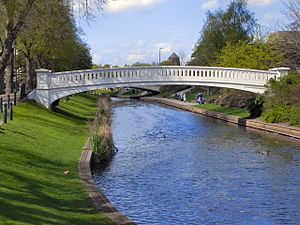River Sow Navigation facts for kids
Quick facts for kids River Sow Navigation |
|
|---|---|

The river at Fairway Bridge
|
|
| Specifications | |
| Locks | 1 |
| Status | abandoned |
| History | |
| Date of act | Privately built |
| Date of first use | 1816 |
| Date closed | 1920s |
| Geography | |
| Start point | Stafford |
| End point | Baswich |
| Connects to | Staffordshire and Worcestershire Canal |
The River Sow Navigation was a short waterway in Staffordshire, England. It connected the Staffordshire and Worcestershire Canal to the town of Stafford. There was a place in Stafford where coal was unloaded, called a coal wharf. The navigation had one lock to connect it to the main canal. It opened in 1816 and stopped being used in the 1920s. Today, there are plans to bring it back to life as the Stafford Riverway Link.
Contents
History of the River Sow Waterway
The Staffordshire and Worcestershire Canal opened in 1772. It linked the River Severn to Birmingham. This canal helped Stafford by having a wharf (a loading dock) at Radford Bank. But goods still had to be moved about 1.5 miles (2.4 km) into town by carts.
Early Plans for a Waterway Link
The first ideas for a waterway to Stafford came in 1798. This plan included bridges (aqueducts) to cross the River Sow and the River Penk. However, this canal was never built. To get goods to Stafford, a horse tramway was built instead. It ran from the town to Radford Wharf. This tramway opened on November 1, 1805.
The Stafford Railway Coal and Lime Company owned the tramway. Horses pulled wagons that could carry about 1.5 tons of coal or lime. The tramway ended near Green Bridge in Stafford. It seems the tramway did not make much money. One owner sold his share for much less than he paid. The company went out of business by 1813.
In 1810, Owen Hall suggested a new waterway. He wanted to make the Penk and Sow rivers usable by boats. He got permission to build a lock at Radford. By 1812, the plans included a special ramp (an inclined plane). This ramp would connect the Penk and Sow to the main canal.
When it was finally built, the plan was simpler. The Sow was connected directly to the canal at Baswich. The lock opened on February 19, 1816. So, the waterway could not have been used before then. Even though it used the river, much of the channel was new. This new path avoided sharp bends in the old river. These old bends remained as oxbow lakes. They could still be seen on maps in 1938.
The canal was built by a private owner. All the land it crossed belonged to Sir George William Jerningham. He later became Lord Stafford. A company called Fereday and Company first leased the waterway. They owned a coal mine. Later, another company took over the lease. In 1838, they sold it to the Staffordshire and Worcestershire Canal company for £50. After this, the waterway was improved. The fees for using it were also lowered.
In Stafford, the navigation had its own channel. It was separate from the river by a narrow strip of land. This strip held the towpath, where horses pulled boats. There was a coal wharf south of the channel. Green Bridge was to the west of this area. The bridge was first built in the 1200s. It was rebuilt in 1781-82 and made wider in the 1860s. A wooden footbridge carried the towpath. It went from the river's north bank to the coal wharf channel's north bank.
Why the Waterway Declined
The Staffordshire and Worcestershire Canal leased the navigation. They rented it from Lord Stafford for many years. But they did not renew the lease in 1927. A person named Adam Boulton leased the coal wharf until 1927. There are no records of it being used after that time.
The coal wharf channel was filled in during the 1930s. A writer named Tom Rolt said the entrance from the canal was blocked in 1944. Stafford Borough Council hoped for its future in 1948. But the waterway kept getting worse. Most of the structures near the lock were removed in the 1970s. This was done to help prevent floods on the Penk and Sow rivers. The Penk river itself was moved into a different channel. It now joins the Sow much closer to St Thomas Bridge.
Plans for Restoration
Canals were being restored and reopened in the 1970s. So, a local canal group suggested restoring this waterway in 1975. They thought it could help reduce traffic on the Staffordshire and Worcestershire Canal. The group asked officials to look into the idea.
The next big step happened in 2002. A resident of Stafford, Keith Taylor, wrote a letter. He said he had found the remains of the lock. The towpath was by then a popular walking route. His idea led to more research by others. This led to the creation of Stafford Riverway Link. This group would lead the restoration efforts. They also aimed to get support from local government. The group became a community interest company in December 2009.
Because of the flood work, the Environment Agency might not allow the old aqueduct to be rebuilt. Engineers from Halcrow Group studied the idea. They suggested a new lock closer to the Staffordshire and Worcestershire Canal. This lock would connect the canal to the River Penk. The new route would either follow the Penk downstream. Or, a new channel would be dug between the two rivers.
The first plan is to reach a temporary end point. This would be just below Green Bridge, near the Asda Supermarket. It is estimated to cost £4.7 million for a waterway 4 feet (1.2 m) deep. For the longer term, the goal is to reach Victoria Park. This is a bit upstream from the town centre. This would increase the cost to £6 million.
Good progress was made in early 2021. Stafford Borough Council gave permission for the first part of the project. This includes building a basin (a wide area for boats) at Baswich. It will have 12 places for boats to stop. It also includes rebuilding the connection to the Staffordshire and Worcestershire Canal. A bridge will also be built across this connection. It will be for people using the towpath and farm vehicles. Before getting permission, the company had already started digging the basin. They were renting the land for a very low price. This was according to the wishes of the late Bill Finney.
The Waterway's Route
The navigation started from the Staffordshire and Worcestershire Canal. It was right across from Baswich Salt Works. A special bridge (a roving bridge) carried the canal towpath over the new channel. The channel then went north. A small aqueduct carried it over a drainage ditch. Then it went into the lock. When the river was at normal levels, the lock lowered boats about 6.5 feet (2.0 m).
The path then turned northwest to join the River Sow. The towpath was on the south bank. Most boats turned left to go upstream (against the current). But boats could also reach St Thomas flour mill a little way downstream. This was not advised when the river was flooding. Right after the junction, the River Penk joined the Sow. A footbridge carried the towpath over where the two rivers met.
The river generally flows west towards Stafford. At Fairway Bridge, the towpath crosses to the north bank. This bridge is where one of the old river bends (oxbow lakes) used to be. The next bridge carried Riverway over the waterway. It has one span and is made of reinforced concrete. William Plant designed it. He was the Stafford Town surveyor and engineer. It officially opened on December 15, 1914.
The next bridge is much newer. It was built in the late 1970s. It carries the A34 road, which is called Queensway here. The coal wharf channel left the river just west of this bridge. It ended just before Green Bridge, which carries Bridge Street.
On the north bank of the river, east of Green Bridge, were public Brine Baths. These were called the Royal Brine Baths after a visit by Princess Mary in 1895. She later became the wife of King George V. There was a boatyard next to the baths in 1907. People could rent canoes and rowing boats there. Boating for fun was very popular at that time.
Places of Interest Along the Waterway
| Point | Coordinates (Links to map resources) |
OS Grid Ref | Notes |
|---|---|---|---|
| Site of Town Mill | 52°48′15″N 2°07′06″W / 52.8042°N 2.1184°W | SJ921229 | Stafford |
| End of navigation | 52°48′17″N 2°06′56″W / 52.8047°N 2.1156°W | SJ923230 | by Green Bridge |
| Start of coal wharf cut | 52°48′16″N 2°06′48″W / 52.8045°N 2.1132°W | SJ924230 | |
| A34 Queensway Bridge | 52°48′15″N 2°06′43″W / 52.8041°N 2.1119°W | SJ925229 | |
| Riverway Bridge | 52°48′14″N 2°06′22″W / 52.8038°N 2.1062°W | SJ929229 | |
| Fairway Bridge | 52°48′12″N 2°05′59″W / 52.8034°N 2.0997°W | SJ933228 | |
| Junction with lock cut | 52°48′11″N 2°05′09″W / 52.8030°N 2.0858°W | SJ943228 | (Penk joined here) |
| Junction with Staffs and Worcs Canal | 52°48′07″N 2°05′04″W / 52.8020°N 2.0845°W | SJ944227 |


